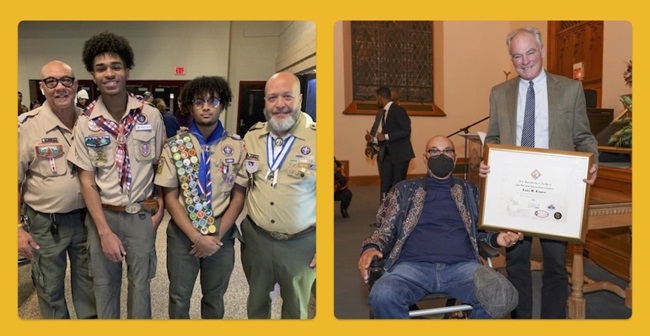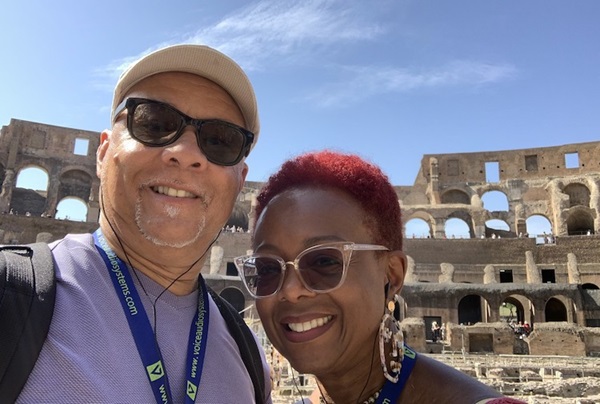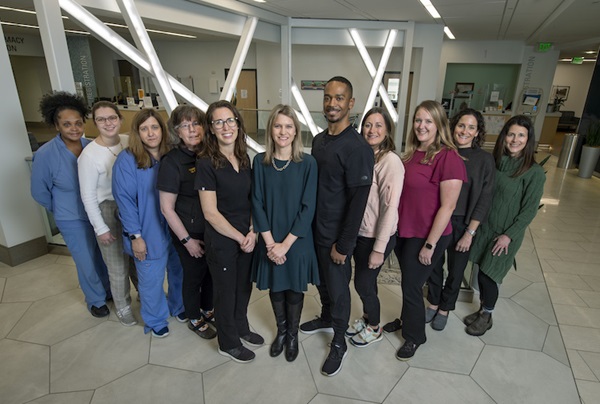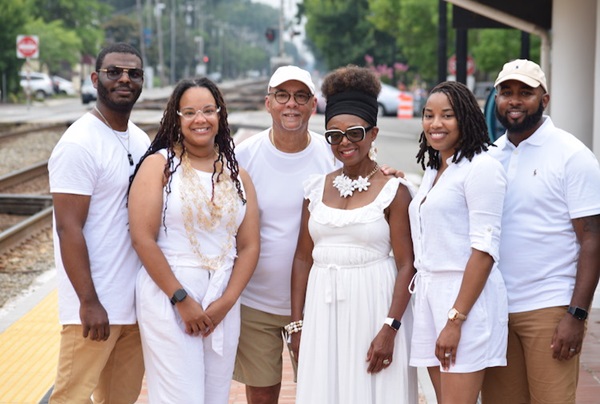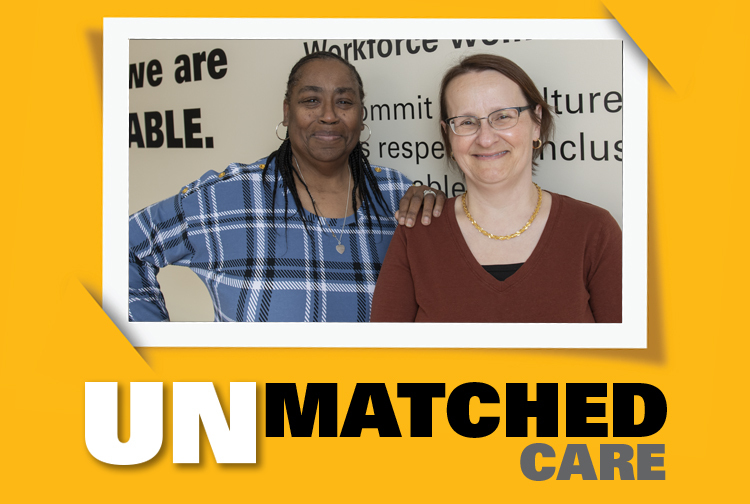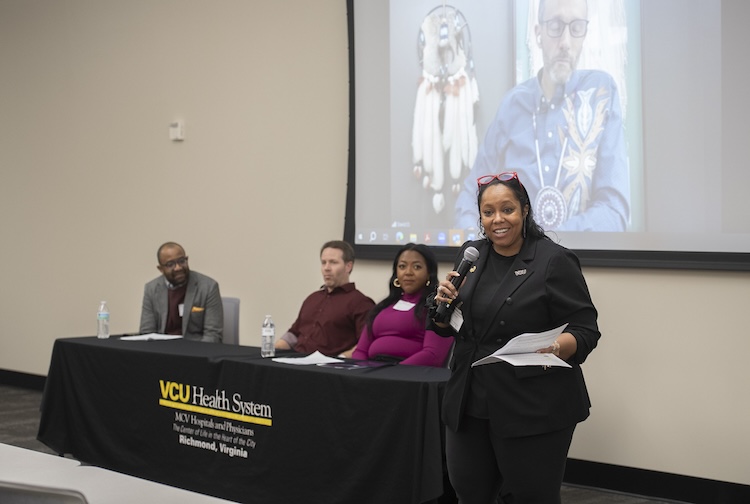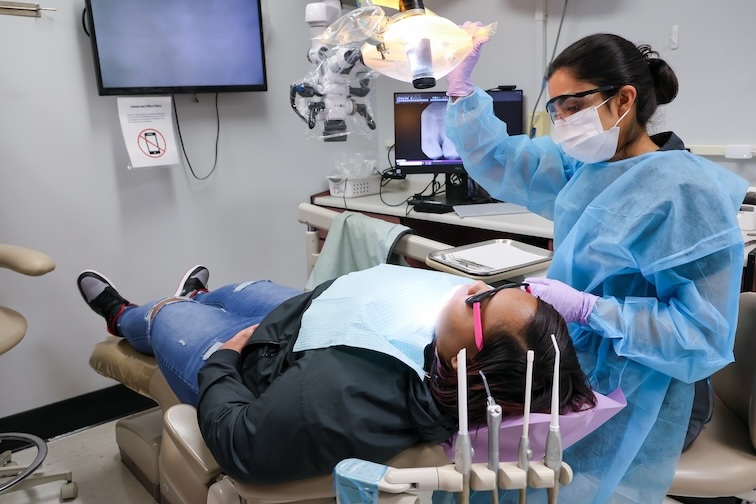
No one left behind: ALS Clinic uncovers racial disparities in diagnostic delays
Researchers at the VCU Health ALS Clinic found that Black patients in Virginia experienced longer delays to being diagnosed with ALS than white patients. Now, they are focused on finding solutions.
April 20, 2023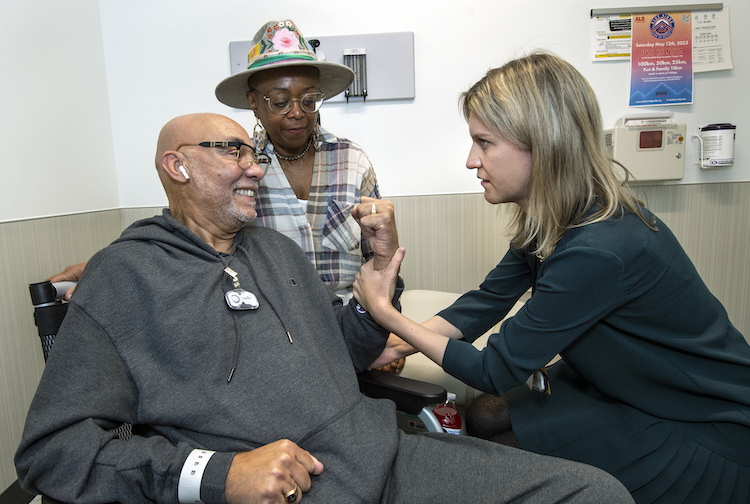 Tony Easter, who has ALS, and his wife Sherry at a recent appointment with Kelly Gwathmey, M.D., at the VCU Health ALS Clinic. (VCU Enterprise Marketing and Communications)
Tony Easter, who has ALS, and his wife Sherry at a recent appointment with Kelly Gwathmey, M.D., at the VCU Health ALS Clinic. (VCU Enterprise Marketing and Communications)
By Olivia Trani
Tony and Sherry Easter have always led an active and adventurous lifestyle. Based just outside of Richmond, the couple have filled their years with raising two children, traveling to new places, exploring the local restaurant scene and playing an active role in their church.
Being outdoors has also been a favorite pastime for Tony, who has led a local Boy Scouts of America troop for more than 40 years.
“I loved hiking and climbing mountains with the kids and watching them grow,” he said. “They call me old school, but I say I’m true school.”
Then, in the summer of 2019, Tony began to develop a limp and experience a sharp pain in his back. Unknown to Tony and Sherry at the time, these health complications were precursors to what would ultimately become a life-changing disease. In August 2021, after two years of meeting with specialists and extensive medical exams, Tony was diagnosed with amyotrophic lateral sclerosis (ALS).
Tony Easter has been very active with the Boy Scouts over the years. He received Martin Luther King, Jr. Lifetime Achievement Award, presented by Senator Tim Kaine, in honor of his many years of service to the community through Boy Scouts. (Contributed Photos)
ALS, also known as Lou Gehrig’s disease, is a rare but relentlessly progressive neurodegenerative illness that gradually kills motor nerve cells in the brain and spinal cord, severely limiting voluntary movement. Over time, it affects a person’s ability to move, speak, swallow and breathe.
For patients with ALS, receiving care quickly is incredibly important, as some treatments are closed off as options once the disease progresses to a certain point. However, receiving a diagnosis for ALS can be a very long process, as was the case for Tony. By the time a patient reports their first symptoms, studies show it takes on average 10 to 16 months before they are given a formal ALS diagnosis.
According to a recent study led by the VCU Health ALS Clinic, the amount of time it takes a patient to receive a diagnosis can also vary significantly by race. By analyzing more than five years of patient data, the research team revealed that Black patients experienced 55% longer diagnostic delays compared to white patients. The findings were presented last fall at the 2022 Annual Northeast Amyotrophic Lateral Sclerosis (NEALS) Consortium Meeting.
“Our results really showed the negative impact that racial healthcare disadvantages have on Black patients with ALS, and this disparity has serious implications for clinical outcomes,” said Kelly Gwathmey, M.D., who directs the VCU Health ALS Clinic and led the research. “The longer it takes you to get a diagnosis, the more delayed you are in terms of getting started on disease-modifying therapies that we know help you live longer. You also are less likely to be eligible for clinical trials or feeding tube placements. This is a huge problem.”
Tony and Sherry Easter live an active lifestyle and love to travel. Here they are on vacation at the Colosseum in Rome, Italy. (Contributed Photo)
A winding path for answers
ALS can be difficult to identify quickly because there is no definitive diagnostic test to confirm the disease and the early-stage symptoms are similar to other types of health issues. As such, ALS is a diagnosis of exclusion, meaning that a variety of tests are performed to rule out other possible causes or disorders. Additionally, from a patient's perspective, limited access to a neurological center, lack of health insurance coverage and financial insecurity can all further exacerbate diagnostic delays.
When Tony began to experience health issues, his doctors tried several medical assessments to find the root of the problem, including x-rays, MRIs and EMG studies, which evaluate the health of muscles and nerves. At the recommendation of his physicians, Tony also underwent spinal fusion surgery and physical therapy, yet his condition still worsened. It wasn’t until Tony experienced a serious fall during a physical therapy session that his medical team referred him to a neurologist.
“I didn’t personally know anybody who had ALS, so it was not on our radar at all. We didn’t even know to ask about testing for ALS,” Sherry said. “We were relying on our doctors to make this connection.”
“This was also during a time when COVID was running rampant, and we knew trying to see a doctor during these times was very, very hard,” Tony added.
Racial disparities brought to light
Over the past few years at the VCU Health ALS Clinic, Gwathmey and her colleagues began to notice that there was a disparity in how long it took for patients to get diagnosed. By analyzing the disease severity of patients at their first clinic visit, the researchers uncovered statistical evidence of what they had suspected: Black patients were more likely to be farther along in their disease compared to white patients by the time they were referred to the clinic.
“There are various metrics that we use to track the progression of a patient’s disease and determine treatment options,” said Gwathmey, who is also chair of the neuromuscular division and an associate professor of neurology in the VCU School of Medicine. “Looking at this data, we found that there was a huge discrepancy in terms of diagnostic delay between Black and white patients.”
Using data collected from 2016 to 2022, the researchers specifically examined the physical and respiratory muscle function of patients when first visiting the clinic.
The physical function of ALS patients is typically measured through a point system, called the ALS functional rating scale (ALSFRS-R), with 48 points representing a person who has complete control of their muscles. Points are deducted from a patient’s score when their disease impacts their ability to perform certain routine physical functions, such as climbing stairs, using utensils or breathing. Respiratory muscle function, also known as a person’s vital capacity, is measured as a percentage. A low percentage indicates that a patient is having a harder time breathing on their own and, with continued progression, may need a noninvasive ventilator.
The data from this study revealed that, when first receiving their ALS diagnosis, Black patients had a lower ALSFRS-R score by 5.6 points and a lower vital capacity score by 14.4 percentage points compared to the scores of white patients.
Gwathmey notes that several factors could be impacting diagnosis delays in the Black ALS community, and more research is needed to identify all the contributing barriers. This may include implicit racial bias among physicians, financial obstacles, lack of access to healthcare, as well as distrust, disinterest or fear of seeking medical attention.
The VCU Health ALS Clinic is a team of multidisciplinary health professionals dedicated to providing comprehensive care for patients with ALS and other motor neuron diseases. (VCU Enterprise Marketing and Communications)
A faster path to diagnosis
In addition to conducting larger studies on the health disparities of ALS, Gwathmey and her team have launched a pilot program in an effort to tackle diagnostic delays head on.
One of the first steps of the initiative, also known as the VCU Health Rapid Access ALS Program, has been to help local health care professionals identify early signs of the disease in their patients. Through webinars, brochures and other resources, the program’s team is working to educate community providers about ALS and provide the tools necessary to rapidly screen patients and refer them directly to ALS specialists at VCU Health.
The only clinic of its kind in the region, learn more about the VCU Health ALS Clinic.
“Most primary care providers will see only one or two ALS cases during their entire career, and in surveys, many primary care providers express a lack of knowledge on the clinical signs of the disease. We hope that increasing awareness of ALS and how to detect the disease will help physicians loop us in faster,” Gwathmey said.
Another key part of this initiative is cutting down patient wait times to visit the ALS Clinic. Patients referred through the VCU Health Rapid Access ALS Program will be seen within four weeks, which will eliminate the need for referral to a community neurologist or a non-neurologist specialist, cut out unnecessary diagnostic testing, and shorten the time to diagnosis.
“I'm often the second, third or fourth neurologist that someone sees before they receive an ALS diagnosis. Our goal is to avoid having patients wait several months to see a neurologist only to wait even more months to get an appointment at our clinic.” Gwathmey said. “Through this pilot program, we’re creating a more direct pathway for patients to see us, so that we can provide earlier access to life-prolonging treatments.”
Providing comprehensive care
For Tony and Sherry, living with ALS has impacted daily life in countless ways, including the house they live in, the car they use, the clothes and shoes Tony wears, and the equipment now needed to perform routine tasks.
“You have to rethink how you go about every single thing. There are so many elements of life that you take for granted,” Sherry said.
Through the VCU Health ALS Clinic, Tony is now receiving the care, medication and resources needed to manage his symptoms and improve his quality of life.
The clinic, which has doubled in patient volume since 2019, is a multidisciplinary team dedicated to providing comprehensive care to patients as soon as they are diagnosed with ALS. The clinic serves as a one-stop shop for a variety of healthcare needs, including physical and occupational therapy, dietary support, social work services as well as clinical research opportunities.
“Once patients are diagnosed with ALS, we work to provide them with anything they might need in terms of equipment, supportive care, symptom management, and disease-modifying therapy,” Gwathmey said. “We are really their home team throughout the duration of their disease and their life.”
“Every day is a different day with ALS, because you don’t know what to expect,” Tony said. “Dr. Gwathmey and her staff have definitely been a blessing to us and I’m sure to many others.”
The Easter family has grown over the years and maintain an active lifestyle. Left to right: Davante Brooks (son-in-law), Kristen Easter Brooks (daughter), Tony and Sherry Easter, Candice Easter (daughter-in-law) and Anthony Easter (son). (Contributed Photo)

